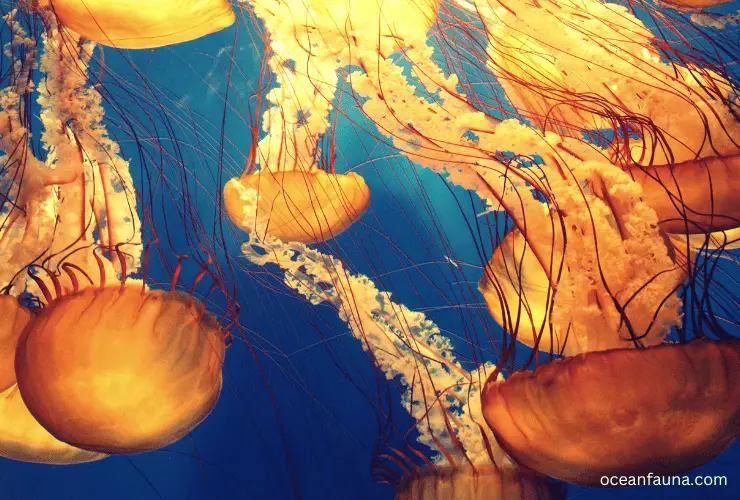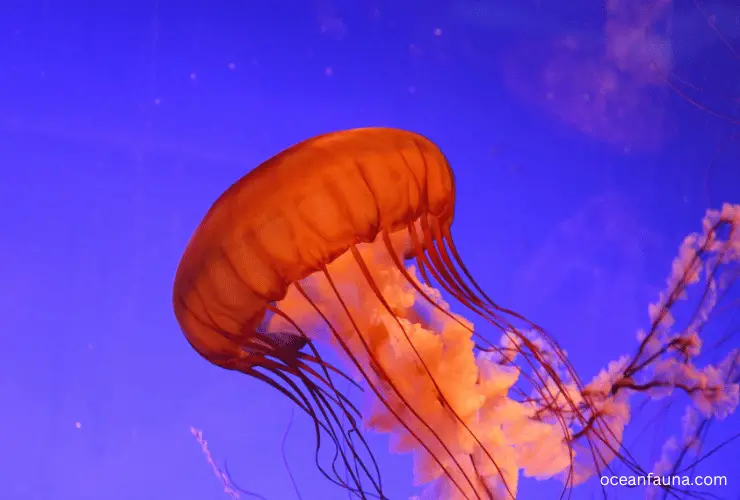Jellyfish poop using the same hole that is used for taking food. They don’t have any separate anuses or holes to eject food waste after digestion. That’s why jellyfish can be called Coelenterata.
Some even say jellyfish don’t poop. They actually Throop, which means throwing up the waste by mouth.
However, jellyfish do eject waste after digestion. The single lane reaching the stomach accepts one meal at a time. And then, they avoid consuming more to throw up the waste from the previous consumption using the same lane.
Reveal The True Mechanism of Jellyfish Pooping Behavior
If any creature snacks on other species directly, it means the creature would surely eject waste from the body after consuming and digesting food. Jellyfish also snack on many small sea creatures like plants and fish eggs.
After gathering enough energy from the food, they surely eject food remains. So, you can’t agree that jellyfish don’t poop in a normal sense.
Earlier, I said that jellyfish Throop. It means pooping, like throwing out waste from the mouth. As you can see, due to having only one hole for both food consumption and waste ejection, you can have a weird thought that jellyfish are throwing out shit from their mouth.
From the odd concept, the term throoping is born for invertebrate creatures like jellyfish and sponges.

How Do Jellyfish Poop and Pee?
Coelenterata creatures don’t have complex digestion systems like mammals. Instead, they contain only one opening in the body that can be used as both entry and exit.
The enzymes living in the jellyfish body get instantly activated when the food is received through the mouth or anus; you can also say manus. After digestion, the remaining food inside the tummy becomes waste. The manus is immediately opened and the waste is ejected into the water.
But jellyfish don’t pee. They only eject wastes through the same hole for eating food. The inner digestion system leaves no waste like urine in the tummy.
What Does Jellyfish Poop Look Like?
The size or color of the jellyfish poop depends on what they’ve eaten earlier. But many proven and reliable science journals have stated that jellyfish poop might look like a few grains of sand. The color is mostly brown or black for several jellyfish species.
But there are exceptions, too, some jellyfish poop grains that glitter under the light. Like online meme images, you can see some jellyfish pooping glitter from their manus when diving underwater.

How Do Comb Jellyfish Poop?
Scientists have stated that comb jellyfish is still evolving. Recently, in the last decade, they’ve evolved some new holes that can be considered pooping holes or anuses.
As comb jellyfish have very transparent bells, researchers can easily see what’s happening inside. The colored remains inside the tummy of a comb jellyfish don’t pick the mouth opening to get released in the water.
Instead, the waste follows the paths leading to new holes that evolved right on the top of the mouth.
So, comb jellyfish poop using anuses rather than the mouth. They have evolved lately to gain a complex digestion system.
Why Does Jellyfish Not Have Two Holes?
It’s easy to understand why jellyfish evolution is not so complete yet very simple. The movement of a jellyfish depends on how fast it can squeeze and spread the whole body with the help of tentacles. If the bell contained complex digestion systems like humans, it would’ve required multiple support organs.
With too many organs inside, the movement, breathing, and survival of jellyfish can become nearly impossible. So, natural evolution has kept the development minimal to ensure no unnecessary body parts grow.
Also, jellyfish don’t eat anything big that can become a complex waste after digestion. Thus, there can be no problem for the manus to throw out the waste like a well-developed anus.
FAQs
Does Any Jellyfish Species Have Anus?
Till now, scientists have only found comb jellyfish to have separate holes under the bell to release food waste into the water. Except for comb jellyfish, it is to be believed that every other jellyfish specie has only one opening for both eating and pooping.
How Much Does a Jellyfish Eat?
Jellyfish can eat 2-3 times a day. The amount of food varies from specie to specie. Predator-class jellyfish often go for smaller shrimp and fish. They snack on their prey 3-4 times a day. Other herbivore jellyfish can even survive by just eating twice a day.
Can Jellyfish Live Without Pooping?
No. If a creature eats something solid, it will surely poop. Jellyfish food habits contain plants, plankton, small fishes, etc. No jellyfish can’t stay alive without pooping. To consume more food and gain energy, the jellyfish must eject previous wastes first and then go for the new food.
Conclusion
Long thing short, jellyfish obviously poop, but they poop using the same opening to eat food. The poop of jellyfish is like grains. So, you may not see jellyfish pooping even if you’re closer.
In a jellyfish’s consumption and digestion system, the path or route is only one. That one route allows the food to go in first. After that, the same route releases the waste so that the jellyfish can eat again to stay alive.
Manus, the combo of mouth and manus, is the biggest opening in the jellyfish bell. Apart from it, most jellyfish bodies have no other hole that can eject waste.

